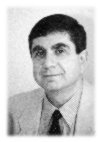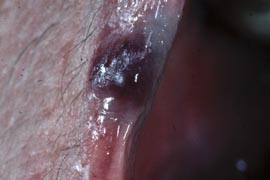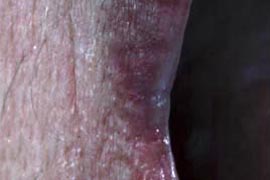 |
Harvey H. Jay, M.D.
|
Harvey H. Jay, M.D.
45 East 62nd. St., New York, NY 10065
Tel: 212-755-2237 * Fax: 212-755-3359


THE LANCET
Harvey Jay, Carmia Borek
Venous-lake angiomas are dilated venules in the upper dermis that are lined by a layer of endothelial cells and a thin wall of fibrous tissue. They appear as tender dark blue nodules and are usually seen on the lips and ears of older people.


Treatment is for cosmetic reasons or because of recurrent bleeding. Treatment of venous lakes by excision, cyrosurgery, or electocoagulation has been complicated by bleeding , swelling, and pain. Treatment with the argon laser may leave scars, and the flashlamp-pulsed-dye laser produces purpura lasting several weeks. An new intense pulsed light source (IPL), the PhotoDerm VL (ESC Medical Systems, Yokneam israel), characterised by a broad spectrum and a longer variable pulse duration, is effective in the treatment of various vascular lesions with minimal side-effects. A pulse width is chosen to deliver light energy within the thermal relaxation time (cooling time) of the target vessels. The large spot size (8 X 35 mm) allows deeper photon penetration. We report treatment of venous angiama with the Photoderm VL IPL. The treated lesion was 11 mm in diameter and 4 mm deep on the rigth upper lip of a 70 year-old woman (figure top), and had been present for over 3 years. A cool thermosculpting gel, BVL (ESC Medical Systems), was applied to the area of the venous lake before treatment. We used wavelengths above 599nm, a triple pulsemode delivering an average fluence of 67.5 J/cm2 in three consecutive pulses, separated by an average 50ms delay, with an average 5.1 ms duration per pulse. Six such triple pulses were delivered to the lesion during one treatment session. No anaesthesia was required. The lesion lightened immediuately after treatment, with no purpura. 33 days after treatment the area was normal in appearance and to palpation.
1. Goldman MP, Fitzpatrick RE. Treatment of cutaneous vascualr lesions. In: Goldman MP, Fitzpatrick RE, eds. Cutaneous laser surgery: the art and science of selective photothermolysis. St Louis: Mosby-Year book, 1994 92-104. 2. Tan TO, Kurban AK. Non congenital benign cutaneous lesions: pulse dye laser treatment. In: Tan OT, ed. Management and treatment of benign cutaneous vascular lesions. Philadelphia: Lea & Febiger, 1992: 163-164. 3. Neuman RA, Knobler RM. Venous lakes (Bean-Walsh) of the lips-treatment experience with the argon laser and 18 months follow-up.Clin Exp Dermatol1990; 15: 115-18 4. Goldman MP, Eckhouse S, ESC Medical Systems Ltd. Photoderm Vl Cooperative Study Group. Phototheraml sclerosis of leg veins.Dermatol Surg 1996; 22: 323-30. 5. Anderson RR, Parrish JA. Selective photothermolysis: precise microsurgery by selective absorption of pulsed radiation. Science 1983; 220: 524-27.
Cornell Universitry Medical College, New York, NY 10065, USA (H Jay); and Department of Community Health, Tufts University School of Medicine, Boston, MA, USA.
[The Scarsdale Inquirer] [CBS Internet Minute] [Newsday]
[THE LANCET] [Health Wise] [Vogue] [Men's Journal]
[Home]
Questions? Comments? Please contact us.
Home - FAQ - Before and After Photos - Skin and Treatment Information - In the News - About Dr. Jay - Contact Us - Site Map
Copyright © Harvey H. Jay, M.D. 1996 - 2011. All Rights Reserved.